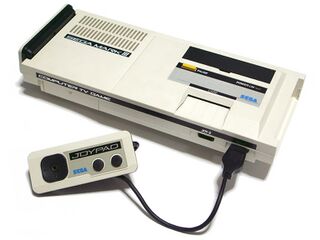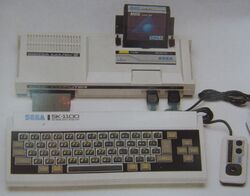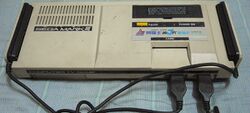Difference between revisions of "Sega Mark III"
From Sega Retro
m (Text replacement - "maker=Sega" to "maker=Sega Enterprises, Ltd.") |
|||
| (10 intermediate revisions by 5 users not shown) | |||
| Line 1: | Line 1: | ||
{{ConsoleBob | {{ConsoleBob | ||
| − | | | + | | logo=SegaMarkIII logo.png |
| consoleimage=MarkIII.jpg | | consoleimage=MarkIII.jpg | ||
| − | + | | maker=[[Sega Enterprises, Ltd.]] | |
| − | | maker=[[Sega]] | ||
| variants=[[Sega Master System]] | | variants=[[Sega Master System]] | ||
| add-ons=[[Demo Unit II]], [[Telecon Pack]], [[FM Sound Unit]] | | add-ons=[[Demo Unit II]], [[Telecon Pack]], [[FM Sound Unit]] | ||
| processor=[[Zilog]] [[Z80]] | | processor=[[Zilog]] [[Z80]] | ||
| releases={{releasesSMS | | releases={{releasesSMS | ||
| − | | sms_date_jp=1985-10-20 | + | | sms_date_jp=1985-10-20{{ref|http://web.archive.org/web/20180712025929/https://sega.jp/history/hard/segamark3/}} |
| − | | sms_code_jp=SG-1000M3{{ref|http://web.archive.org/web/ | + | | sms_code_jp=SG-1000M3{{ref|http://web.archive.org/web/20130223233135/http://sega.jp/fb/segahard/mk3/data.html}} |
| − | | sms_rrp_jp=15,000{{ref|http://web.archive.org/web/ | + | | sms_rrp_jp=15,000{{ref|http://web.archive.org/web/20130209183653/http://sega.jp/fb/segahard/mk3/}} |
| − | | sms_date_kr= | + | | sms_date_kr=1988-11<ref>https://archive.ph/rIyg5</ref> |
| − | | sms_date_tw= | + | | sms_date_tw=198x |
}} | }} | ||
}} | }} | ||
| Line 26: | Line 25: | ||
The system is backwards compatible with earlier SG-1000 titles, both in terms of cards and cartridges, and likewise, the controllers are interchangeable. Cartridges and cards are the same physical shape as their SG-1000 counterparts, but will not function in an SG-1000. Sega also released the [[Telecon Pack]], allowing the Mark III to connect to a television wirelessly. | The system is backwards compatible with earlier SG-1000 titles, both in terms of cards and cartridges, and likewise, the controllers are interchangeable. Cartridges and cards are the same physical shape as their SG-1000 counterparts, but will not function in an SG-1000. Sega also released the [[Telecon Pack]], allowing the Mark III to connect to a television wirelessly. | ||
| − | In the early days, the Mark III was marketed as an upgrade to both the SG-1000 and [[SC-3000]], with accessories such as the [[Sega Keyboard]], [[4 Color Plotter Printer]] and [[Data Recorder SR-1000]] even mentioned on the console's box as parts of a "complete" system. Few, if any Mark III games make use of these peripherals - whereas the diagrams suggest Mark III games could have been distributed on compact cassette, none were, likely as | + | In the early days, the Mark III was marketed as an upgrade to both the SG-1000 and [[SC-3000]], with accessories such as the [[Sega Keyboard]], [[4 Color Plotter Printer]] and [[Data Recorder SR-1000]] even mentioned on the console's box as parts of a "complete" system. Few, if any Mark III games make use of these peripherals - whereas the diagrams suggest Mark III games could have been distributed on compact cassette, none were, likely as no Mark III-enhanced BASIC interpreters (or other operating systems) were ever released. |
The Sega Mark III was redesigned as the Sega Master System for release in other markets. This was mainly a cosmetic revamp; the internals of the console remained largely the same. The redesigned console was itself released in Japan in 1987, but with the features of the FM Sound Unit built in as well as a [[3-D Glasses|3-D glasses]] port and a built-in [[Rapid Fire Unit]]. | The Sega Mark III was redesigned as the Sega Master System for release in other markets. This was mainly a cosmetic revamp; the internals of the console remained largely the same. The redesigned console was itself released in Japan in 1987, but with the features of the FM Sound Unit built in as well as a [[3-D Glasses|3-D glasses]] port and a built-in [[Rapid Fire Unit]]. | ||
| Line 40: | Line 39: | ||
===Technical specifications=== | ===Technical specifications=== | ||
| − | :''See [[Sega Master System | + | :''See [[Sega Master System/Technical specifications|Sega Master System technical specifications]].'' |
====Processors==== | ====Processors==== | ||
* Main CPU: [[Zilog]] [[Z80]] | * Main CPU: [[Zilog]] [[Z80]] | ||
| − | + | :* Instruction set: 8-bit instructions | |
| − | + | :* Clock rate: 3.579545 MHz | |
====Graphics==== | ====Graphics==== | ||
| Line 52: | Line 51: | ||
* Screen [[resolution]]s: 256x192 and 256x224 pixels | * Screen [[resolution]]s: 256x192 and 256x224 pixels | ||
* Color palette: 64 colors | * Color palette: 64 colors | ||
| − | + | :* Simultaneous colors on screen: Up to 32 (64 using programming tricks) | |
* Sprites: Up to 64 sprites on screen | * Sprites: Up to 64 sprites on screen | ||
| − | + | :* Sprites pixel sizes: 8x8 or 8x16 pixel sprites | |
| − | + | :* 8x8 [[pixel]] characters, max 488 (due to [[VRAM]] space limitation) | |
* Horizontal, diagonal, vertical, and partial screen scrolling | * Horizontal, diagonal, vertical, and partial screen scrolling | ||
}} | }} | ||
| Line 62: | Line 61: | ||
* Sound chip (PSG): [[Texas Instruments]] [[SN76489]], integrated with VDP | * Sound chip (PSG): [[Texas Instruments]] [[SN76489]], integrated with VDP | ||
* 4 channel mono sound | * 4 channel mono sound | ||
| − | + | :* 3 sound generators, 4-10 octaves each | |
| − | + | :* 1 white noise generator | |
====Memory==== | ====Memory==== | ||
* System [[RAM]]: 24 KB | * System [[RAM]]: 24 KB | ||
| − | + | :* Main RAM: 8 KB | |
| − | + | :* Video RAM ([[VRAM]]): 16KB | |
===Other=== | ===Other=== | ||
| Line 89: | Line 88: | ||
===South Korea=== | ===South Korea=== | ||
| − | The Mark III was distributed in South Korea by [[Korea Oacs]], and was the first Sega console to be sold in the country. | + | The Mark III was distributed in South Korea from November 1988 by [[Korea Oacs]] and [[HiCom]] with help from [[Samsung]], and was the first Sega console to be sold in the country. Sega planed to produce 50,000 units in 1989<ref>https://archive.ph/rIyg5</ref>, but plan was abolish after Samsung released Gam*Boy in April 1989 and all new software was labelled as compatible with Mark III/Gam*Boy. |
==Games== | ==Games== | ||
| Line 99: | Line 98: | ||
*''[[Hang-On]]'' (Sega Card) | *''[[Hang-On]]'' (Sega Card) | ||
*''[[Teddy Boy Blues]]'' (Sega Card) | *''[[Teddy Boy Blues]]'' (Sega Card) | ||
| + | |||
| + | ==Production credits== | ||
| + | {{creditstable| | ||
| + | *'''Team Leader:''' [[Masami Ishikawa]] | ||
| + | *[[Hideki Sato]] | ||
| + | | source=Developer mentions{{ref|https://www.famitsu.com/news/201308/12038274.html}}{{fileref|Sega_Consumer_History_JP_EnterBrain_Book.pdf|page=23}} | ||
| + | | console=SMS | ||
| + | }} | ||
==Magazine articles== | ==Magazine articles== | ||
| Line 107: | Line 114: | ||
SegaMarkIIIJPLeaflet.pdf|JP flyer | SegaMarkIIIJPLeaflet.pdf|JP flyer | ||
</gallery> | </gallery> | ||
| + | |||
| + | ==External links== | ||
| + | * [http://web.archive.org/web/20180712025929/https://sega.jp/history/hard/segamark3/ Sega of Japan catalogue page (Japanese)] | ||
==References== | ==References== | ||
Latest revision as of 10:37, 6 November 2024

| ||||||||||||||||||||
| Sega Mark III | ||||||||||||||||||||
|---|---|---|---|---|---|---|---|---|---|---|---|---|---|---|---|---|---|---|---|---|
| Manufacturer: Sega Enterprises, Ltd. | ||||||||||||||||||||
| Variants: Sega Master System | ||||||||||||||||||||
| Add-ons: Demo Unit II, Telecon Pack, FM Sound Unit | ||||||||||||||||||||
|
The Sega Mark III (セガマークIII) is a video game console created by Sega. It is the successor to Sega's earlier SG-1000 II (itself a redesigned SG-1000), and was released in October 1985 in Japan, before being distributed in South Korea and Taiwan later in the decade. No models of the Mark III were released outside of Asia, but the console did form the basis of the Sega Master System which was distributed internationally.
The Mark III stands as Sega's second attempt at capturing a share of the Japanese video game market in the face of the Family Computer (Famicom) created by Nintendo, sporting significant upgrades over its predecessors. The technology was used as a foundation for its successor, the Sega Mega Drive.
Contents
Hardware
The Mark III is built similarly to the SG-1000 II, so much so that to the untrained eye, it is easy to mistake one for the other. It is a long, white system sporting a cartridge slot, a card slot, and two DE-9 controller ports at the front of the unit. On the left lies an expansion port, later utilised by the FM Sound Unit, and in addition to the RF television output, an 8-pin A/V port, giving greater picture quality than the system's predecessors. Like the SG-1000 II (and Famicom), controllers (now SJ-152s) can be docked on either side of the unit.
The Mark III offers two major upgrades over the SG-1000 (with the optional FM Sound Unit bringing enhanced sound) - superior visuals offered by a new video display processor, and more RAM. Generally this is represented by twice as many on-screen colours and sprites, and smoother scrolling - everything else is largely the same as the SG-1000. The upgrade puts it ahead of the Famicom in many regards, although without the FM Sound Unit, the Famicom has technically superior sound capabilities (furthered still by the Famicom Disk System add-on).
The system is backwards compatible with earlier SG-1000 titles, both in terms of cards and cartridges, and likewise, the controllers are interchangeable. Cartridges and cards are the same physical shape as their SG-1000 counterparts, but will not function in an SG-1000. Sega also released the Telecon Pack, allowing the Mark III to connect to a television wirelessly.
In the early days, the Mark III was marketed as an upgrade to both the SG-1000 and SC-3000, with accessories such as the Sega Keyboard, 4 Color Plotter Printer and Data Recorder SR-1000 even mentioned on the console's box as parts of a "complete" system. Few, if any Mark III games make use of these peripherals - whereas the diagrams suggest Mark III games could have been distributed on compact cassette, none were, likely as no Mark III-enhanced BASIC interpreters (or other operating systems) were ever released.
The Sega Mark III was redesigned as the Sega Master System for release in other markets. This was mainly a cosmetic revamp; the internals of the console remained largely the same. The redesigned console was itself released in Japan in 1987, but with the features of the FM Sound Unit built in as well as a 3-D glasses port and a built-in Rapid Fire Unit.
Models
- Main article: Master System consoles in Asia.
Technical specifications
Processors
- Instruction set: 8-bit instructions
- Clock rate: 3.579545 MHz
Graphics
- Graphics processor (GPU): VDP (Video Display Processor), derived from TMS9918
- Screen resolutions: 256x192 and 256x224 pixels
- Color palette: 64 colors
- Simultaneous colors on screen: Up to 32 (64 using programming tricks)
- Sprites: Up to 64 sprites on screen
- Horizontal, diagonal, vertical, and partial screen scrolling
Sound
- Sound chip (PSG): Texas Instruments SN76489, integrated with VDP
- 4 channel mono sound
- 3 sound generators, 4-10 octaves each
- 1 white noise generator
Memory
- System RAM: 24 KB
- Main RAM: 8 KB
- Video RAM (VRAM): 16KB
Other
- The Sega Mark III does not have a BIOS ROM
- Game card slot
History
Background
Sega's first console, the SG-1000, launched on the same day as the Famicom in Japan, and was, like many other systems of the era, decimated by Nintendo's efforts. Its computer sibling, the SC-3000 was met with more open arms (including in some Australasian and European markets), but by 1985 it was clear that support for Sega's systems were drying up. Nevertheless, Sega's attempts were at the very least notable - whereas other rival systems of the day had been struck off within a year of the Famicom's launch, Sega held a strong, albeit distant, second place in Japan, prompting the company to push forward with a more powerful alternative - the Sega Mark III.
Japan
The Mark III was released in Japan on October 20, 1985, with its main competition again being the Family Computer. Despite being a cartridge-based system, for the first eight months, no traditional cartridges were produced, with the library instead being populated by cost-reduced Sega Cards. The release of Fantasy Zone ushered in a new phase of cartridge production, and support lasted until February 1989, ending with Bomber Raid.
Over one million units were sold in Japan during Mark III's first year, but similar to its predecessors, the Mark III was unable to dethrone Nintendo or win considerable support from the gaming public. The situation is said to have been an improvement over the SG-1000/SC-3000's fate, but even with superior system specifications, Mark III sales paled in comparison to the Famicom's. By 1989, the Sega Mark III had sold over 1.7 million units in Japan.
Sega published every Mark III game internally with the exception of two, Argos no Juujiken and Solomon no Kagi: Oujo Rihita no Namida by Salio.
Taiwan
In Taiwan, Aaronix distributed the Mark III, having previously brought the SG-1000 II to the region.
South Korea
The Mark III was distributed in South Korea from November 1988 by Korea Oacs and HiCom with help from Samsung, and was the first Sega console to be sold in the country. Sega planed to produce 50,000 units in 1989[5], but plan was abolish after Samsung released Gam*Boy in April 1989 and all new software was labelled as compatible with Mark III/Gam*Boy.
Games
List of games
- Main article: List of Master System games.
Launch titles
Japan
- Hang-On (Sega Card)
- Teddy Boy Blues (Sega Card)
Production credits
- Team Leader: Masami Ishikawa
- Hideki Sato
Magazine articles
- Main article: Sega Mark III/Magazine articles.
Promotional material
External links
References
- ↑ https://sega.jp/history/hard/segamark3/ (Wayback Machine: 2018-07-12 02:59)
- ↑ http://sega.jp/fb/segahard/mk3/data.html (Wayback Machine: 2013-02-23 23:31)
- ↑ http://sega.jp/fb/segahard/mk3/ (Wayback Machine: 2013-02-09 18:36)
- ↑ https://archive.ph/rIyg5
- ↑ https://archive.ph/rIyg5
- ↑ https://www.famitsu.com/news/201308/12038274.html
- ↑ File:Sega_Consumer_History_JP_EnterBrain_Book.pdf, page 23
| Sega Home Video Game Systems | ||||||||||||||||||||||||||||
| 83 | 84 | 85 | 86 | 87 | 88 | 89 | 90 | 91 | 92 | 93 | 94 | 95 | 96 | 97 | 98 | 99 | 00 | 01 | 02 | 03 | 04 | 05 | 06 | 07 | 08 | 09 | 10 | 11 |
|---|---|---|---|---|---|---|---|---|---|---|---|---|---|---|---|---|---|---|---|---|---|---|---|---|---|---|---|---|
| SG-1000 | SG-1000 II | Mega Drive | Mega Drive II | |||||||||||||||||||||||||
| SC-3000 | Mega-CD | Mega-CD II | Genesis 3 | |||||||||||||||||||||||||
| Sega Mark III | 32X | Dreamcast | ||||||||||||||||||||||||||
| Master System | Master System II | |||||||||||||||||||||||||||
| AI Computer | Game Gear | |||||||||||||||||||||||||||
| Saturn | ||||||||||||||||||||||||||||
| Pico | Beena | |||||||||||||||||||||||||||
| Sega Master System | |
|---|---|
| Topics | Sega Master System | Technical Specifications (Hardware Comparison) | History | Boot ROM | Magazine articles | Promotional material | Merchandise |
| Hardware | Asia | North America | Western Europe | Eastern Europe | South America | Australasia | Africa Sega Mark III | Sega Game Box 9 | Master System Girl | Master System Super Compact | Kiosk | Sega System E |
| Add-ons | Demo Unit II | Telecon Pack | FM Sound Unit | 3-D Glasses |
| Controllers | SJ-152 | Control Pad | 3-D Glasses | Control Stick | Handle Controller | Light Phaser | Paddle Control | Rapid Fire Unit | Sports Pad | SG Commander |
| Misc. Hardware | Action Replay | Card Catcher | Action Case | Freedom Connection | Playkit |
| Unreleased | Floppy Disk Drive |
| Consoles-on-a-chip | Arcade Gamer Portable | TF-DVD560 | DVD Karaoke Game DVT-G100 | Fun Play 20-in-1 | Handheld Electronic Games | Master System 3 Collection | Master System 3 | Master System Evolution | Master System Handy | PlayPal Plug & Play | Poga |



